Forced air is still the traditional method of heating homes, but radiant heat is gaining significant momentum as an alternative. According to HGTV, the growth rate of in-floor radiant heating systems was estimated at 30 to 50 percent per year. At the heart of this shift is not just one single benefit. It’s a variety of advantages Read more
Industry Blogs

Forced air is still the traditional method of heating homes, but radiant heat is gaining significant momentum as an alternative. According to HGTV, the growth rate of in-floor radiant heating systems was estimated at 30 to 50 percent per year.
At the heart of this shift is not just one single benefit. It’s a variety of advantages that radiant floor heating systems bring to the table, the combination of which enhance the daily lives of a home’s occupants:
Even Heat Distribution
When a house is heated by a forced-air system, it will always be warmest near the vents that distribute the air. This can lead to “hotspots” on one end of a room while the other side of the room remains cool. And because hot air rises, upstairs rooms will be warmer than those downstairs.
With radiant floor heating systems, homeowners control how heat circulates in their home. Rather than heating the surrounding air, the heat that radiates from the floor warms other objects in the room and is evenly distributed without the potential for heat loss.
Improved Air Quality
While air pollution is more often associated with the outdoors, indoor air can be dirty as well. Whether it’s dust, pet dander or chemicals from fragrances (among other sources) that pollute the air, forced-air systems exacerbate the problem for allergy sufferers. That’s because the forced, heated air will stir up and mix with these airborne particles.
Since radiant floor heating systems don’t move air to deliver heat, the circulation of indoor particles is minimized. With less pollutants blown around, indoor air quality improves, which benefits allergy sufferers.
No Ductwork
The ductwork in forced-air systems further contributes to air pollution. When it’s riddled with cracks and holes, more dust and odors can enter and circulate. Without proper insulation, these same cracks and holes can cause air to leak out of the system and hinder its overall efficiency.
With no ducts, radiant floor heating systems reduce the churn of dust and allergens while curtailing heat loss. The absence of ducts means less work for homeowners as it eliminates the need for repairs like cleaning out ducts clogged with particles or adding insulation when heat loss mounts.
Energy Savings
With their uneven distribution of heat and potential for heat loss, traditional heating systems can be energy hogs.
Depending on how well a house is insulated, radiant floor systems can save up to 30 percent compared to forced-air systems. In terms of bills, the impact is quite significant as space heating is the largest energy expense for the average U.S. home, accounting for around 45 percent of energy bills.
Noiseless Operation
Homes should be quiet, but forced-air systems can be noisy as furnaces cycle on and off, gaps in the ductwork whistle and loose parts rattle.
By comparison, radiant floor heating systems are exceptionally quiet.
As consumers learn more about the advantages of radiant heating, its popularity will continue to grow.
 Josh Quint is product manager, heating and cooling, for Viega LLC.
Josh Quint is product manager, heating and cooling, for Viega LLC.
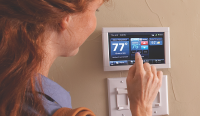
It’s easy to become overwhelmed when thinking about the Internet of Things (IoT) and the complexities of smart home appliances and products. However, it’s never too late to educate yourself on the smart HVAC features and products that are sought by today’s customers. Before the dawn of the smart age, HVAC controls were synonymous with Read more
It’s easy to become overwhelmed when thinking about the Internet of Things (IoT) and the complexities of smart home appliances and products. However, it’s never too late to educate yourself on the smart HVAC features and products that are sought by today’s customers.
Before the dawn of the smart age, HVAC controls were synonymous with a simple thermostat that provided comfort from a system designed to focus only on heating or cooling a space. Functionality and practicality were the most vital roles of an HVAC system. With the increased role that technology plays in our daily lives, a lot has changed.
It’s no secret that smart home technology has reshaped the way consumers interact with their homes on a day-to-day basis. Now more than ever, consumers demand the ability to change their home’s climate with the push of a button or a simple voice command – without ever touching the thermostat and from anywhere, whether sitting on a couch or away on vacation. The focus has gone from practicality to the accessibility and convenience that come with an integrated smart HVAC system. Simply put, consumers demand more from their HVAC systems.
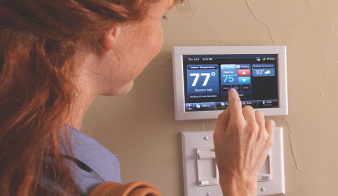 Considering this smart home revolution, technology advancements have allowed for HVAC systems to evolve faster than can be absorbed by those in the field who must explain the functionality of the systems they are selling. How can one fully learn and understand the value of today’s smart HVAC? Dedicated time to learn about this rising tide of technology is important, but equally as helpful is to install and use similar HVAC-connected smart products within your own home. First-hand experience and determining how it can benefit your life will simplify explaining the value proposition to customers.
Considering this smart home revolution, technology advancements have allowed for HVAC systems to evolve faster than can be absorbed by those in the field who must explain the functionality of the systems they are selling. How can one fully learn and understand the value of today’s smart HVAC? Dedicated time to learn about this rising tide of technology is important, but equally as helpful is to install and use similar HVAC-connected smart products within your own home. First-hand experience and determining how it can benefit your life will simplify explaining the value proposition to customers.
While the smart home revolution has markedly changed the products, services, and accessibility HVAC dealers can offer, making the sale comes back to the homeowner’s perceived financial outlay and return on investment. Knowing how to explain the value in energy savings and diagnostic capabilities throughout the life of the product can help make the case for the more costly, higher efficiency system. Similarly helping consumers understand the value of convenience from a connected systems, such as voice interactions through Alexa, or even Geofence-based set points through the app, are paramount to moving customers up to a connected system.
It also provides an avenue to become a trusted advisor for your customers while building lifelong relationships for not only yourself, but also for the brands you’re selling. While a robust consumer value proposition is key to making the initial sale, the long term value to a contractor of a connected customer is even more impactful. Using remote diagnostic capabilities, servicing dealers can better maintain the customer relationship over time, deliver more efficient service when required, and be in the best position for a proactive replacement at the end of the product lifecycle.
By being transparent and showcasing factors such as energy savings, user experience, cross-device capabilities, etc. dealers can leverage the smart home revolution to position themselves as knowledgeable and trustworthy.
Because smart home technology has reshaped the way HVAC systems are viewed within the greater home ecosystem, it should be noted that not everyone (or every home) is right for a smart HVAC installation. Consumers often do their own research before consulting dealers about whether a technologically advanced HVAC system is right for their home. In the end, an educated consumer can be the best barometer for whether upgrading to a smart HVAC system makes the most sense.
 George Land, Connected Home Solutions General Manager for Ingersoll Rand Residential HVAC
George Land, Connected Home Solutions General Manager for Ingersoll Rand Residential HVAC

Marketing is everywhere. When you’re scrolling your Facebook feed, there are companies marketing their products to you based on your search history. When you’re driving down the interstate, companies are taking a broader approach by putting their offer on a billboard. Simply put, if you’re not allocating part of your budget to marketing each year Read more
Marketing is everywhere. When you’re scrolling your Facebook feed, there are companies marketing their products to you based on your search history. When you’re driving down the interstate, companies are taking a broader approach by putting their offer on a billboard. Simply put, if you’re not allocating part of your budget to marketing each year, then you’ll quickly get passed by. No matter how amazing you are at your craft, it will happen!
 To introduce myself, my name is Doug Stine, Stine-Nichols Plumbing, North Kansas City, Mo., and I’ve been in the plumbing industry for more than 40 years. Throughout that time span, I’ve seen the industry change course a number of times. From adapting to new plumbing technology to making the transition from employee to business owner, there’s certainly been a fair share of adjusting. Going hand-in-hand with this, I always like to share this quote with colleagues and friends. “It is not necessary to change. Survival is not mandatory.” This comes from one of the leading thinkers in the management world, W. Edwards Deming. In nearly every industry (plumbing included), not that many companies survive long term. A huge part of this is directly correlated with willingness to adapt to change. Even within your own business, you’ll notice certain employees shy away from change. They’re used to doing things one way and are hesitant to disrupt their daily routine. In the end, it isn’t easy to change, but it’s mandatory to truly survive and thrive as a business.
To introduce myself, my name is Doug Stine, Stine-Nichols Plumbing, North Kansas City, Mo., and I’ve been in the plumbing industry for more than 40 years. Throughout that time span, I’ve seen the industry change course a number of times. From adapting to new plumbing technology to making the transition from employee to business owner, there’s certainly been a fair share of adjusting. Going hand-in-hand with this, I always like to share this quote with colleagues and friends. “It is not necessary to change. Survival is not mandatory.” This comes from one of the leading thinkers in the management world, W. Edwards Deming. In nearly every industry (plumbing included), not that many companies survive long term. A huge part of this is directly correlated with willingness to adapt to change. Even within your own business, you’ll notice certain employees shy away from change. They’re used to doing things one way and are hesitant to disrupt their daily routine. In the end, it isn’t easy to change, but it’s mandatory to truly survive and thrive as a business.
In this article, I wanted to discuss why you’ll need to be top-notch on your marketing to maintain your market share of new leads. For some, making this transition might be a major adjustment. Just remember, if you don’t adapt now, the gap is just going to get bigger between you and your competitors. So, without further ado, let’s look into a few main reasons as to why marketing will help you generate new leads and grow your brand!
Everyone is There
If all of your potential customers are on social media, don’t you think you should be too? Well, the answer to this question is short and sweet: of course, you should! Referrals are huge in plenty of businesses. In fact, I’ll go into the topic of reviews later on to give you a hint at that. However, you can’t rely on referrals to be your only source of new business. Eventually, you’ll spend your days cold-calling old clients to see if they know anyone that needs plumbing help. And in an industry that has projects typically pop up out of the blue, this isn’t going to be too fun of a process? (Not to mention the fact that you may get some annoyed former clients!)

You need to tap into another avenue to generate some leads. Lucky for you, there’s plenty of them waiting on Facebook, Instagram and other social media platforms. With this, we have a couple tips: (1) Don’t just post to post. Consistent content is critical. You have to post relevant content to keep your audience engaged. However, once you start posting just to hit a certain number of posts for the week, you start losing your audience. Keep it plumbing focused, but at the same time there’s a happy medium in making it fun and relevant material. (2) Paid ads can work. Most people are under the impression that plumbing is tough for which to market. Not true! If you don’t believe me, take a look at your top competitors. Are they posting regularly? Maybe (if they’re big enough) they are even running commercials on TV? Well, if this tells you anything, it should be that they are spending money. Remember the old adage: you have to spend money to make money? If you don’t already know it, this saying is without a doubt applicable in running a small business!
Only Way to Scale
No matter what industry you’re in, every small business owner starts out by wanting to grow their business as big as possible. You have big dreams of expanding your team, being an industry leader and ultimately making more money on your bottom line. Scaling a business like this requires you to be able to acquire new customers and then do a satisfactory job with those clients. In most cases, this two-step approach encompasses the entire production side of a plumbing business. So, you’ve got the technician part of the puzzle complete (assuming you’re a trained plumber and have experienced professionals on your team), now you just need to keep new prospects walking through your door. The only way to keep a constant flow of leads is through marketing. Social media management, SEO strategies (both local and general), web design, and so on. All of these hold the keys to scaling your brand!
Makes Your Life Easier
Personally speaking, one of the most stressful aspects of running your own business is all the many financial factors. Particularly in a small business, chances are you’re wearing many hats. On top of managing everything, in the back of your head, you’re thinking about whether or not you have money to make payroll on Friday. When a truck goes down, you’re thinking about how to get it fixed asap to keep your team rolling, while not breaking the bank to get it repaired. Simply put, it can be a lot! Perhaps, nothing can be more stressful than getting to the point where you only have a handful of new jobs on your project queue. You can be the best boss in the world, but if there are no leads coming in, your employees are going to have to leave (and probably go to one of your local competitors). An effective marketing strategy can put this to rest easily.
Reviews are Everything
Take a look at the Google listing for some of the top plumbing companies in your area. Now look at how many reviews they have. I’m guessing they all have at least a couple hundred. Obviously, some of the newer companies are still building up their portfolio, but for the most part, all the established businesses are going to have plenty of reviews to back up their stellar work.
Customer testimonials represent a wing of marketing called “Reputation Management.” Essentially, this shows the public that you’re a reputable business. You know what you’re doing and your past clients will vouch for your professionalism. For smaller everyday plumbing jobs, potential customers are going to want a business that shows up on-time, fixes the problem correctly the first time, and doesn’t charge an outlandish amount of money to do so. Reviews are your way to prove that you’ll do just that.
Don’t Be Afraid to Outsource
For the past 40+ years, I’ve been a plumber and for part of that time, owned my own plumbing company. I’ve seen everything from flooded basements, water main breaks, you name it. Ultimately, I feel fairly confident saying that I’ve nearly seen it all when it comes to plumbing and know how to troubleshoot through new situations. To be completely honest with you though, I would not say I’m an expert marketer. Nor after 40 years in the plumbing industry do I want to become one. With that said, I’ve quickly found the benefit in outsourcing tasks that you’re either not trained to complete or ones that you simply don’t have time to do.
If I can offer you one piece of actionable advice, it’s to focus your time and energy on what you’re best at. This piece of advice is something that’ll allow you to grow your business and essentially become more profitable!
Any Questions?
I’d like to thank the team at Mechanical Hub for allowing me to do this guest blog post on how marketing affects plumbing. Running a small business is certainly no walk in the park. However, having the lead generation process under control can definitely make it a little less-stressful. If you have any questions about marketing, feel free to reach out to me through our Facebook page or email dstine@stinenichols.com. If I can’t answer it, I’ll have someone from our marketing team help you out!

The difference between cast iron soil pipe and plastic is easily understood when it comes to sound. Cast iron drain waste and vent pipe systems are superior when it comes to sound attenuation. For commercial office buildings, hospitals, high-rise condominiums or high-end hotels, no one wants to listen to the flowing of fluids when a Read more
The difference between cast iron soil pipe and plastic is easily understood when it comes to sound. Cast iron drain waste and vent pipe systems are superior when it comes to sound attenuation. For commercial office buildings, hospitals, high-rise condominiums or high-end hotels, no one wants to listen to the flowing of fluids when a toilet is flushed from the floor above.
Specifying cast iron for waste piping provides a plumbing system that is up to 11 times quieter than an all-plastic system. This is how it got its name – the Quiet Pipe®.
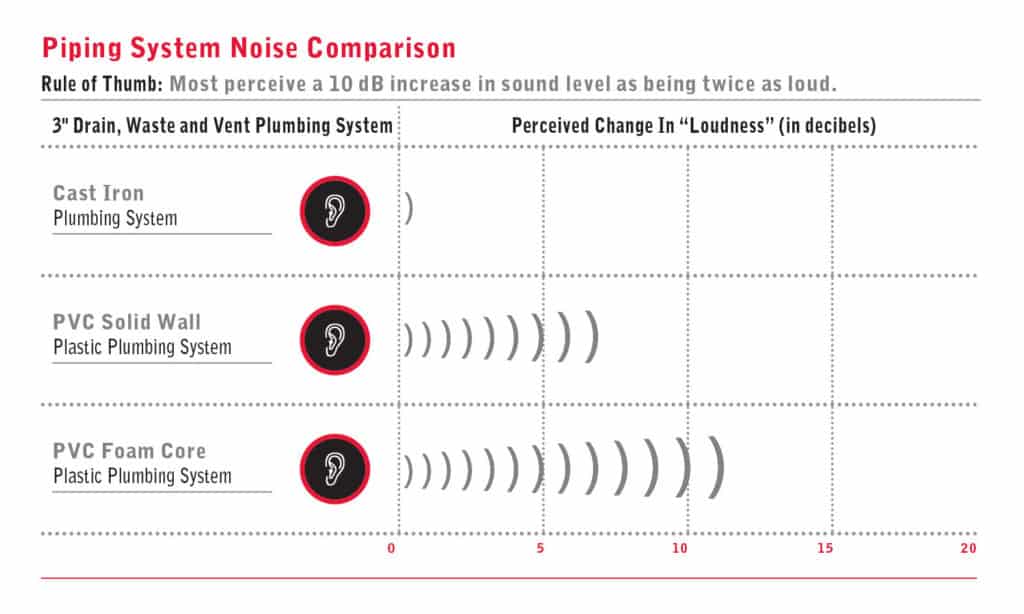
A primary factor in cast iron’s sound-dampening quality is its microstructure. Graphite flakes absorb and dampen vibration applied to the iron. The microstructure isn’t the only advantage when it comes to noise.
Cast iron installation plays a primary role in sound attenuation. The use of neoprene rubber gaskets to join sections of cast iron pipe provides additional sound dampening. Sections of pipe do not touch as the rubber gasket creates a buffer, and so contact-related sound is eliminated. In contrast, plastic systems are installed as rigid systems that are solvent cemented. Noise is created as the rigid system expands and contracts with heating and cooling.
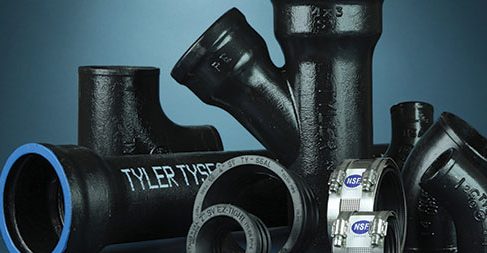 A frequently used tactic attempts to create a solid barrier between the pipe and the wall: wrapping plastic pipe in insulation to muffle the sound of rushing water and fluids through pipes. An insulated plastic pipe, however, can be sound-enhancing rather than sound-deadening. The “fix” results in additional installation costs incurred for both product and labor.
A frequently used tactic attempts to create a solid barrier between the pipe and the wall: wrapping plastic pipe in insulation to muffle the sound of rushing water and fluids through pipes. An insulated plastic pipe, however, can be sound-enhancing rather than sound-deadening. The “fix” results in additional installation costs incurred for both product and labor.
Specify cast iron soil pipe and enjoy the benefits of the Quiet Pipe®.
Check out cast iron soil pipe’s other benefits.
 Dave Parney is the Executive Vice President of the Cast Iron Soil Pipe Institute (CISPI) and a former Master Plumber in the Chicago area.
Dave Parney is the Executive Vice President of the Cast Iron Soil Pipe Institute (CISPI) and a former Master Plumber in the Chicago area.
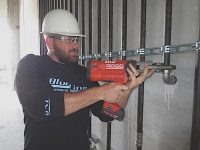
One of the things that keeps contractors up at night is worrying about where their next qualified hire is going to come from. The shortage of skilled workers in the trades is severe and getting worse. Seventy percent of construction companies nationwide are having trouble finding qualified workers, according to the Associated General Contractors of Read more
 One of the things that keeps contractors up at night is worrying about where their next qualified hire is going to come from.
One of the things that keeps contractors up at night is worrying about where their next qualified hire is going to come from.
The shortage of skilled workers in the trades is severe and getting worse. Seventy percent of construction companies nationwide are having trouble finding qualified workers, according to the Associated General Contractors of America.
And if Congress ever does approve a much-needed infrastructure package, the need will be even greater.
We in the trades can hope parents will stop pushing the necessity of a four-year degree to every child, regardless of interest or qualifications, but there are more practical measures we can take in the meantime.
Last year, Viega LLC launched the Viega Trades Education Network (VTEN) to boost the ranks and skills of students studying the design, installation and function of plumbing and hydronic systems. Viega is partnering with trade schools, community colleges and the UA in the United States and Canada to subsidize and provide training on mechanical systems.
VTEN is about providing a better education for those already enrolled and supporting the schools and instructors that are training the next generation of workers. Like all educational institutions, these schools don’t have the budgets and resources to deliver everything they’d like to give their students.
As members of VTEN, schools get comprehensive curriculum modules that easily integrate into existing programs. The modules include Hydronics 101, Piping & Controls, Radiant Design, Trades Math, Blueprint Reading, CAD and BIM, and more. In addition, Viega provides functional demonstration units supported by lesson plans and projects and a complete tooling package.
Educators receive admission to an annual VTEN conference in Colorado or New Hampshire, including hotel, airfare, food and admission; Viega and direct vendor support of BlueVolt® eLearning platform; hands-on tool demonstrations and LoopCAD® license options and instructor training.
The LoopCAD package includes on-site orientation to the network and a Zoning Demonstration Board and Mixing Demonstration Board to give students hands-on experience in troubleshooting systems.
And, of course, VTEN offers credentialed classes for Viega products, including ProPress® and MegaPress®.
But the program doesn’t stop there. Schools also receive a RIDGID® RP-340 tool or Milwaukee M18® Force Logic Press Tool with a set of jaws for metal and PEX, as well as samples of various types of pipe and couplings for each student.
The first students in VTEN will graduate soon and we welcome them to the ranks of the trades. We invite other companies to follow suit and join us in building the workforce of the future.
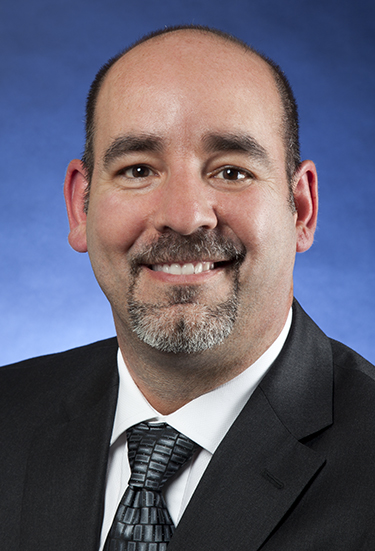 Lino Santoro is Viega Trades Education Network (VTEN) Manager.
Lino Santoro is Viega Trades Education Network (VTEN) Manager.
